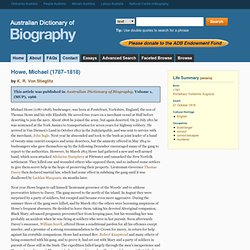

Clarke brothers. Thomas (1840?

-1867) and John Clarke (1846? -1867) were Australian bushrangers from the Braidwood district of New South Wales responsible for a series of high-profile robberies and killings in the late 19th century so notorious that they led to the embedding of the Felons' Apprehension Act (1866), a law that introduced the concept of outlawry and authorised citizens to kill criminals on sight.[1] Active on the southern goldfields from 1865, Thomas, John, their brother James and a host of relations were responsible for a reported 36 hold-ups and the deaths of five policemen - four of them "special constables" bounty hunters - looking to bring them in.
In 1866, the gang held the town of Michelago, New South Wales captive while awaiting the arrival a gold escort from Kiandra. Some modern-day writers have described the Clarkes as the "bloodiest" bushrangers of all. They were hanged at Sydney's Darlinghurst jail on 25 June 1867. Michael Howe. Michael Howe (1787-1818), bushranger, was born at Pontefract, Yorkshire, England, the son of Thomas Howe and his wife Elizabith.

He served two years on a merchant vessel at Hull before deserting to join the navy. About 1806 he joined the army, but again deserted. On 31 July 1811 he was sentenced at the York Assizes to transportation for seven years for highway robbery. He arrived in Van Diemen's Land in October 1812 in the Indefatigable, and was sent to service with the merchant, John Ingle. Next year he absconded and took to the bush as joint leader of a band of twenty-nine convict escapers and army deserters, but the amnesty offered in May 1814 to bushrangers who gave themselves up by the following December encouraged many of the gang to report to the authorities.